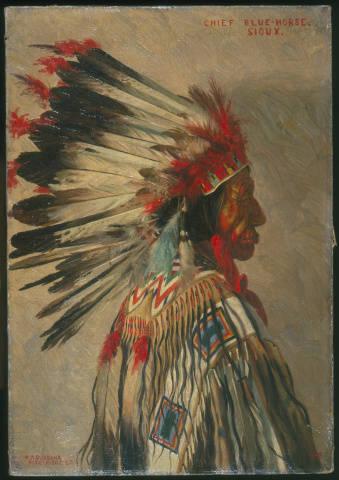According
to [Richard] Hardorff, Blue Horse was born
about 1821.
Blue
Horse in 1872:
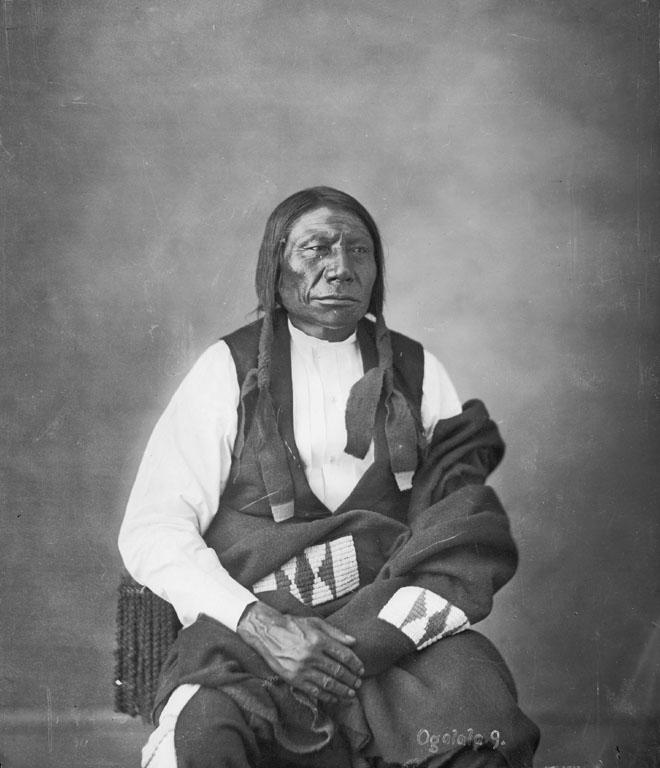
Photo
by Alexander Gardner (SIRIS)
— Dietmar Schulte-Möhring
I've
found the reference about Blue Horse and Red
Cloud being born on the same year and day,
but I still lack any info about his death date.
I've three pictures of him as an old man:
The
Heyn one:
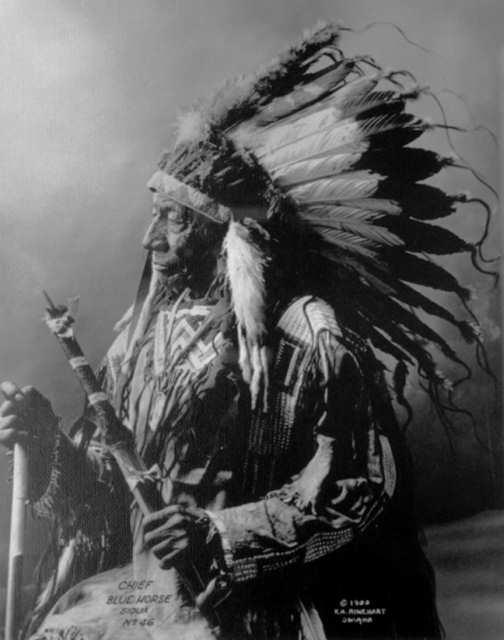
Another
one taken in 1900:
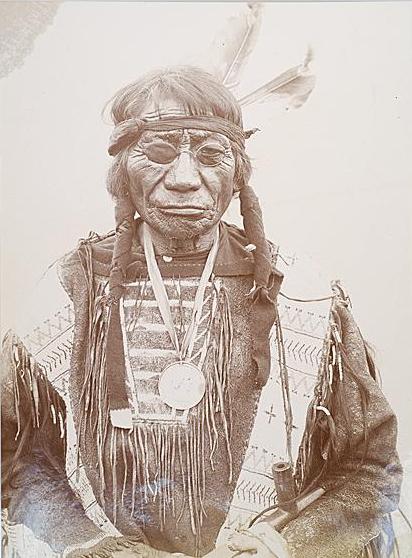
And
an Edward Curtis one (1907):

All
I know then is that he was still around by 1907.
And
this is the one taken at the 1901 Pan-Am in Buffalo, New
York:
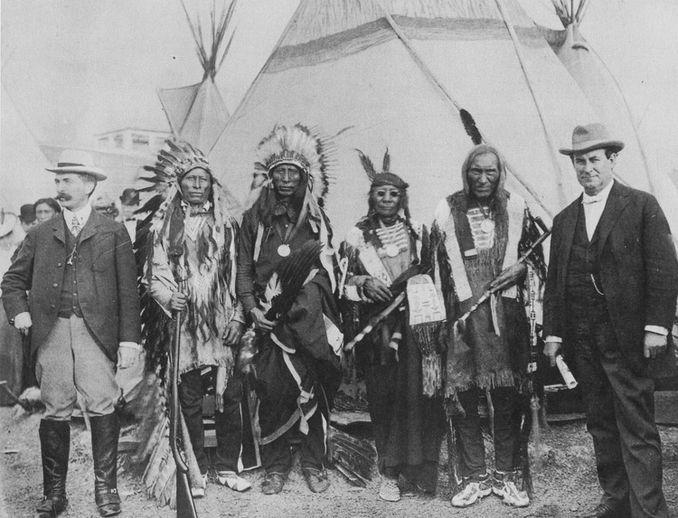
Left
to right: F. T. Cummings, High Hawk,
Jack Red Cloud, Blue Horse, Little
Wound, William Jennings Bryan —
jinlian

Isn't
this Blue Horse in the front row of this group? And isn't
that an older Red Shirt
at the right of the back row?
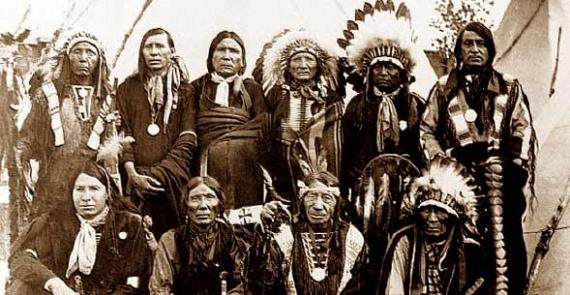
—
Grahame Wood

The
third man on the left (first row) in your first photo
is just Blue Horse! I suppose it was taken at another
exposition - Omaha 1898, maybe? —
jinlian

Shot-in-the-Eye
is standing far left in the back row, and Painted
Horse stands left of Red Shirt, I think.
— Dietmar Schulte-Möhring

On
a vaguely related note, was the Blue Horse that travelled
with Cody in 1887-8 actually a Shoshone? Seeing this thread
reminded me that I'd read somewhere that Cody would pass
off some of his Lakota as members of other tribes for
"dramatic" purposes.
Anyhow,
for completists' sake, here is THAT Blue Horse:

—
Grahame Wood

I
think the man in the cabinet card you've posted is definitely
Blue Horse the Shoshone. Being born in 1821 or 1822, our
Oglala Blue Horse would have been about 65 at the time.
—
jinlian

I
think what Grahame means is that this Blue Horse could
be a son or nephew of our Blue Horse. From the way he
looks I would say he could very well be a Lakota ... or
perhaps the Shoshone changed their hairstyle during this
period to attract Cody's audience. —
Dietmar Schulte-Möhring

Well,
it was partly due to shows such as the Wild West that
the Lakota paraphernalia became essential in the representation
of the "traditional" Indian. The necklace and
the breastplate worn by the Indian in the picture are
definitely Lakota, but unfortunately this doesn't help
much with the identification, as we're speaking about
an "actor." On the other hand, changes of hairstyle
were quite common among native tribes: I think for instance
of the Pawnee hairstyle, or even the Crow, whose peculiar
pompadour was adopted quite late (since the 1840s).
I've
checked Mike Stevens' tiyospaye website and it
reports that there was in fact another Blue Horse, son
of Stands Good, born in 1869. According
to the same website, our Blue Horse, the Wagluhe,
had a son called Little Medicine, born
in 1867. Anyway, I think it's possible that Blue Horse
had more children than those reported there and that one
of them toured with Cody: Stevens's records are based
on census data which aren't 100% accurate.
Here
are the last two images of Blue Horse have in my collection:
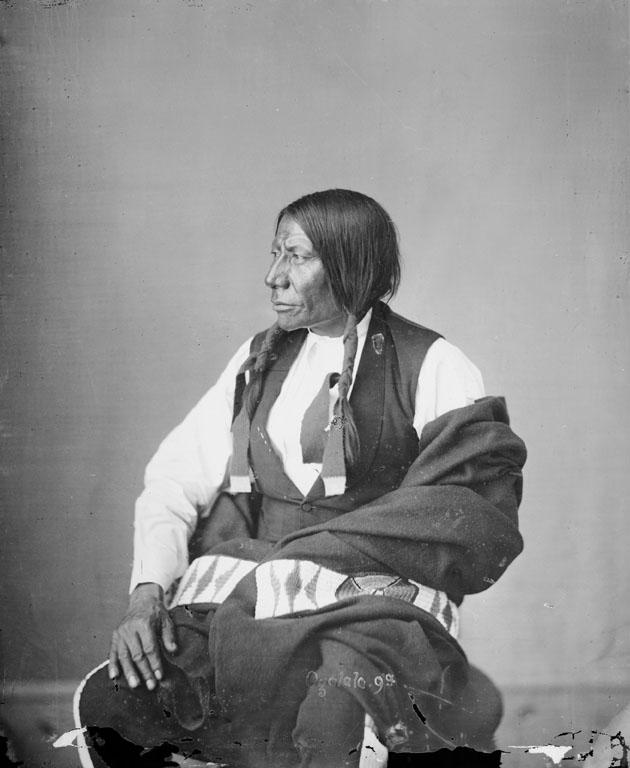
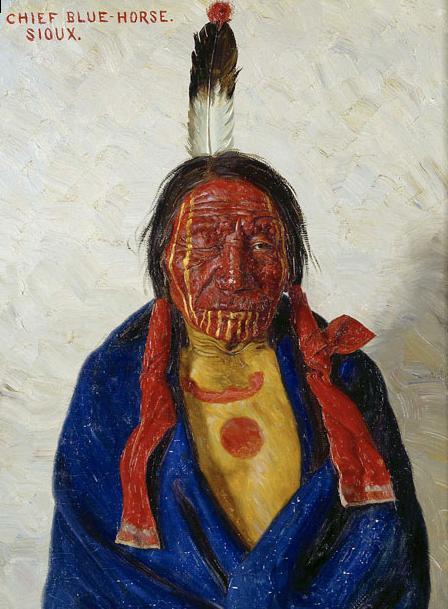
Blue Horse's Portrait by E. Burbank
A
detail to make identification easier: Blue Horse lost
his right eye sometime between 1880 and 1895. —
jinlian

Blue
Horse (M)
(1820-), #16477 — Blue Horse – Oglala – 1872 Blue
Horse was born in 1820; SHON-KEE-TOH.
He witnessed the meeting of Chief Dull Knife; The Treaty of Fort Laramie was an agreement
between the United States and the Lakota nation, signed
in 1868 at Fort Laramie in the Wyoming Territory, guaranteeing
to the Lakota ownership of the Black Hills, and further
land and hunting rights in South Dakota, Wyoming, and
Montana. The Powder River Country was to be henceforth
closed to all whites. The treaty ended Red Cloud's War.
The treaty included articles intended to "insure
the civilisation" of the Lakota; financial incentives
for them to farm land and become competitive - and stipulations
that minors should be provided with an "English education"
at a "mission building". To this end the US
government included in the treaty that white teachers,
blacksmiths and a farmer, a miller, a carpenter, an engineer
and a government agent should take up residence within
the reservation. Repeated violations of the otherwise
exclusive rights to the land by gold prospectors led to
the Black Hills War.
http://www.pbs.org/weta/thewest/resources/archives/four/ftlaram.htm.
Blue Horse was listed as Head of the Household on the
Indian Census at Pine Ridge Indian Reservation, Dakota
Territory, USA, in 1886. Blue horse was listed as Head
of the Household on the Indian Census at Pine Ridge Indian
Reservation, Wakpamini District, Shannon Co., Dakota Territory,
USA, on June 30, 1904.
Council
Fire Woman (F)
(1830-),#16478 — Council Fire Woman was also known
as Peta Ominiciye.
She was born in 1830. She was listed as Blue Horse's wife
in a census in 1886 at Pine Ridge Indian Reservation,
Dakota Territory, USA. She was listed as Blue Horse's
wife in a census on June 30, 1904 at Pine Ridge Indian
Reservation, Wakpamini District, Shannon Co., Dakota Territory,
USA.
Little
Medicine (M)
(1867-), #19274
Little Medicine was born in 1867. He was the son of Blue
Horse and Council Fire. Blue Horse was listed in the Indian
Census on the date of in 1886 at Pine Ridge Indian Reservation,
Dakota Territory, USA; Blue Horse is listed as 67 on this
Census. His Wife Council Fire was listed as 55 years old.
Jennie
Blue Horse (F)
(1873-), #19275
Jennie Blue Horse was born in 1873. She was the daughter
of Blue Horse and Council Fire. Blue Horse was listed
in the Indian Census on the date of in 1886 at Pine Ridge
Indian Reservation, Dakota Territory, USA; Blue Horse
is listed as 67 on this Census. His Wife Council Fire
was listed as 55 years old.
Lizzie
Blue Horse (F)
(1874-), #1927
Lizzie Blue Horse was born in 1874. She was the daughter
of Blue Horse and Council Fire.
— LaDonna Brave Bull
Allard

In
1869 Spotted Tail
killed Blue Horse's brother Big Mouth
at Whetstone agency. Here is a newspaper sketch of that
incident:

There
was a photograph taken of Big Mouth and his brother Blue
Horse among others by photographer Ridgway Glover at Fort
Laramie in 1866. Unfortunately Glover got killed and his
photographs are lost in mystery.
— Dietmar Schulte-Möhring

The
sketch of the Big Mouth assassination shows however a
surprisingly accurate portrait of Spotted Tail, even more
striking when we think of some caricatures featuring in
the contemporary illustrated press. I suppose the fact
that pictures of Spotted Tail circulated widely helped
too.
On
the other hand, I've always found amazing the strong resemblance
between Blue Horse and Red Cloud. They were first cousins,
but they certainly looked as if they were twins! —
jinlian

Blue
Horse died in the Wakpamni District on the Pine Ridge
Reservation on July 16, 1909. —
Ephriam Dickson

George
Hyde stated that Blue Horse (Sunkawakan To) and
his brother Big Mouth (I Tanka) belonged, in
origin, to Itesica band (the same of Red Cloud).
Later (I think by marriage) he became a Wagluhe
(Loafers), a band that generally camped around Fort Laramie
(Wyoming). He was born in 1821. —
Charlie

Here's
another of the four portraits of Blue Horse by Elbridge
A. Burbank:
